Boatbuilding, like writing, can be a solitary preoccupation. Working out problems on your own time, with your own logic, is often best done in isolation. It isn’t uncommon for a boatbuilder to consult half a dozen references, seek advice from a couple of other builders at a boat show—and then go ahead and do what he was going to do anyway.
A recording of a home boatshop might reveal only a series of whacks and thuds, the momentary screech of a power tool, the scraping of a plane blade, more whacks and thuds, and maybe the occasional grunt or groan. It’s a kind of music. But only when the boat is launched and begins to live its own life will it prove the merits or faults of each decision. And when the boat sails or rows in company with others— that’s when its true personality will emerge.
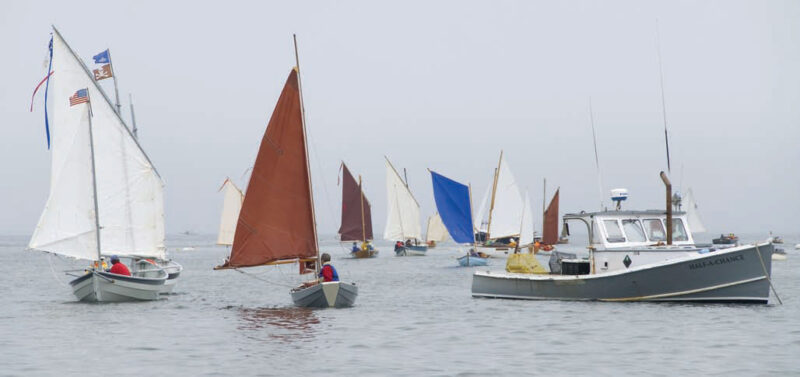 Benjamin Mendlowitz
Benjamin MendlowitzIn conceiving the 2007 Small Reach Regatta, we had envisioned the cove filled with lugsails, spritsails, gaff sails, tanbark-colored sails, white sails (and maybe a blue one), pulling boats—and there it was, everything we had hoped for. For three days, the waters off WoodenBoat swarmed with small boats.
For decades now, boatbuilders have been able to participate in a wide variety of small-craft gatherings and festivals. In recent years, events of longer duration and more adventurous ambitions—especially the weeklong races known as Raids in Europe and now elsewhere (see WoodenBoat magazine No. 187)—have provided more opportunities to put boats through their paces in meaningful ways. Such events are intended for participants rather than spectators. Not all of these participants are boatbuilders, of course, but even those who have purchased boats are equally keen to fit out and handle them to best advantage, even if racing isn’t part of the program.
In 2007, building on these concepts, WoodenBoat held the first of what we’re calling the “Small Reach Regatta,” a gathering for three days of day-sailing off the WoodenBoat waterfront in Brooklin, Maine. (Well, the second one, technically: we invited a very small group of friends in 2006 to help evaluate the idea.) The name is a takeoff on classic yachting’s well-known Eggemoggin Reach Regatta, held in the same location each August for wooden boats 26′ on deck and longer. Our thought was to have an event of similar character for small boats, and we very rapidly filled our fleet quota of 40.
The variety proved gratifying. We had Kingston lobsterboats, traditional Scandinavian faerings, Swampscott dories, fast pulling boats, fast daysailers, traditionally built boats, plywood boats—and a gaggle of Iain Oughtred designs, including six Caledonia yawls and two Ness yawls. Because we partnered for the event with the Downeast Chapter of the Traditional Small Craft Association, which does not exclude fiberglass boats of traditional design, we even had three fiberglass boats in the fleet.
The logistics of the coast of Maine are challenging. There are few large parks for overnighting with a large group like this. The island network called the Maine Island Trail is superb for small groups but out of the question for large ones. We settled on a simple solution: use WoodenBoat’s shorefront for day outings and for camping ashore each night.
At the outset, we asked for a show of hands of those interested in racing. Not a single hand went up. One reason for sailing in company is to encourage builders and sailors to compare notes on such things as the fine points of sheet leads, clever solutions to problems, interesting setups for gear storage, types of line, advantages of various sail types, inspiration for what type of boat to build next, and dozens of other ideas. Another reason is to push the envelope of experience.
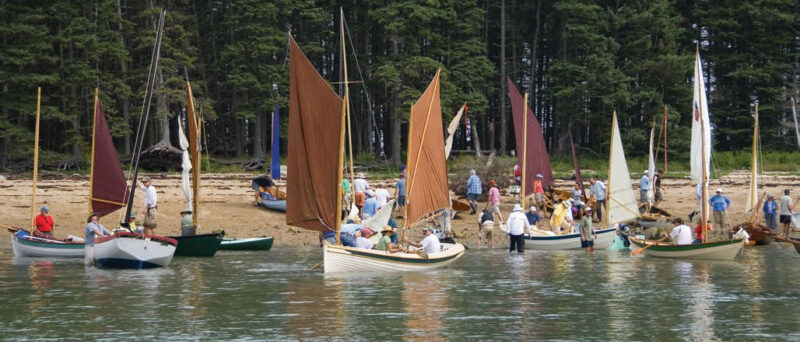 Benjamin Mendlowitz
Benjamin MendlowitzAs spectacular as it is to see so many boats sailing in company, it is equally satisfying to see them come in to shore for a lunchtime haulout. Here, the beaching advantages or disadvantages of various types become quickly evident. A spirit of volunteerism reigned during the 2007 Small Reach Regatta, and whenever someone needed help to haul a boat higher up the beach, or to relaunch, many hands were quick to respond. Here, too, was an opportunity to share observations, meet new friends, talk about boats, and maybe take an interesting boat out for a bit.
The old granite coast of Maine gave us just about all of her variety in three days. We had a strong breeze in dense fog, cloudy skies with moderate breeze, and a hot morning with no breeze at all. She charitably spared us thunderstorms and rain. Most of the skippers had many years of experience, but for a few, saltwater navigation was new. Some of our skippers were old WoodenBoat hands, like Sam Manning, a frequent illustrator of books and articles; Willits Ansel, who long ago taught in our school; and Maynard Bray, our technical editor.
Local skippers shared their knowledge readily. On another day of 15 knots of breeze and fog coming in, some sailors might have decided to stay at home in the easy chair. But in a fleet with this much experience—even with admonishments that the decision about whether to go is the skipper’s alone—the urge to sail with the fleet is a strong one. Maybe some will break down and peel off the bills for one of those nice handheld GPS units after such a foggy morning with rocks and islands abounding. And even without a race, it’s a rare sailor who won’t pay attention to sail trim when another is passing under his lee.
It’s often impossible to predict what a crowd of strangers will be like, but with small-craft people, it’s a pretty fair bet they’ll be among the best. Some came from far away, including one group that came from Virginia laden with cured ham, peanuts, and the makings for mint juleps for all. Some came from right here in town. Some came with children and grandchildren. Everyone pitched in with a spirit of volunteerism to launch boats, haul out, clean up, or whatever else came up. But the final reason, the best reason, for doing such a thing is to see a fleet of great boats well-handled in spectacular surroundings. And what a sight it is!
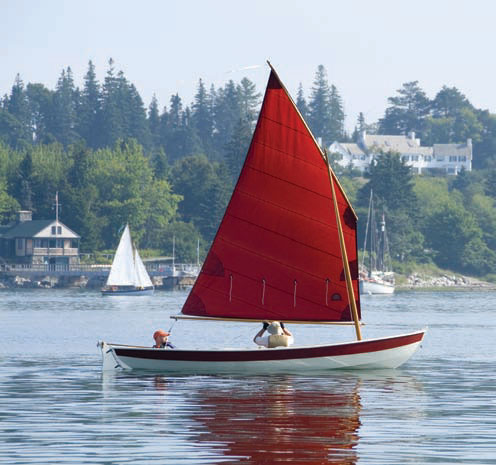
John and Susan Silverio sail OCARINA, an 18′ Joel White-designed Shearwater.
The WoodenBoat waterfront is no stranger to the 18′, lugrigged, Joel White–designed Shearwater, since the school has one in its own small-boat fleet. OCARINA, however, is from Lincolnville, across Penobscot Bay from WoodenBoat’s home in Brooklin. Behind her, WoodenBoat’s boathouse and main office building mark the extent of the waterfront. Most of the 2007 Small Reach Regatta participants, including OCARINA’s owners, John and Susan Silverio of Lincolnville, Maine, camped at the WoodenBoat School campground. Holding the event off the WoodenBoat waterfront simplified the logistics of housing and trailer hauling and parking.
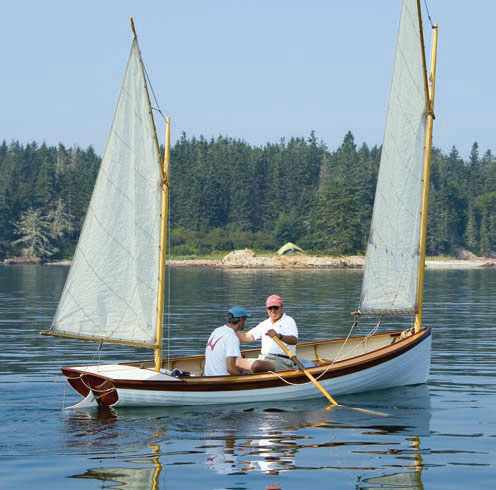 Benjamin Mendlowitz
Benjamin MendlowitzThe 16’8″ Hereshoff-designed Coquina, WIZARD.
It doesn’t take much of a breeze to move a 16′ 8″, N.G. Herreshoff–designed Coquina. So when the oars come out on WIZARD, you can rest assured that there is nothing, or very close to nothing, for breeze. That was the case this particular Sunday morning of the 2007 Small Reach Regatta, when the fleet rowed to Center Harbor, some 2.5 miles away, for a “harbor burn.” The breeze filled in later, but from almost exactly the direction of the lunchtime destination—a matter of little concern to a boat that points to weather as well as WIZARD does.
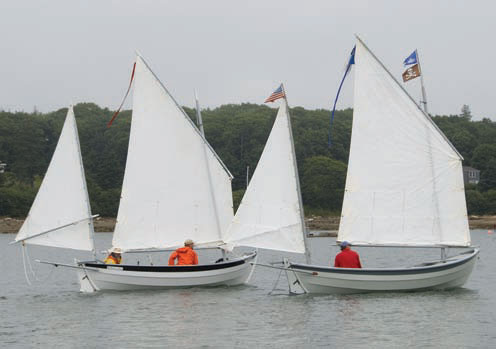 Benjamin Mendlowitz
Benjamin MendlowitzJay Eberly’s REBECCA ANN (left) and Geoff Kerr’s NED LUDD.
Australian designer Iain Oughtred, now living in Scotland (note: Iain Oughtred passed away Feb. 21, 2024), was far and away the most-represented designer in the 2007 fleet. Six Caledonia yawls, a Ness yawl, and an Elf faering, all built to his designs, made up about 18 percent of the 39 boats in the fleet. Several of them were built by Geoff Kerr, whose NED LUDD (right above) has been a fixture at wooden boat events in the Northeast for years. Kerr builds boats at Two Daughters Boat Works in Westford, Vermont, and his three-part how-to-build article on the Caledonia yawl started in WB No. 183. Alongside is Jay Eberly’s REBECCA ANN, one of two boats that came from Virginia to join the fleet.
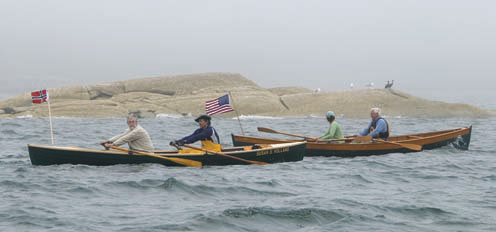 Benjamin Mendlowitz
Benjamin MendlowitzRowboats SUSAN B. HOLLAND (left) and PUCK.
Rowing is often an advantage—when the wind is contrary, there is sometimes no better way to get from Point A to Point B. As a pure pulling boat, PUCK has no sailing rig at all. She was designed and beautifully built by Harry Bryan, an off-the-grid boatbuilder in New Brunswick who is also a teacher at WoodenBoat School and a contributing editor toWoodenBoat. PUCK’s owners, Bob and Judith Yorke of Scituate, Massachusetts, love to row, and they have taken their boat far and wide, from Massachusetts to Nova Scotia.
She is similar in concept to the SUSAN B. HOLLAND, which was on loan from the Floating the Apple boatbuilding program for disadvantaged youth in Brooklyn, New York. Bob Wolfertz of New Jersey—and he is hardly alone in this— didn’t quite finish his Caledonia yawl in time for the regatta, but he was able to borrow the pulling boat, which is flatbottomed instead of round-bottomed like PUCK, for the event.
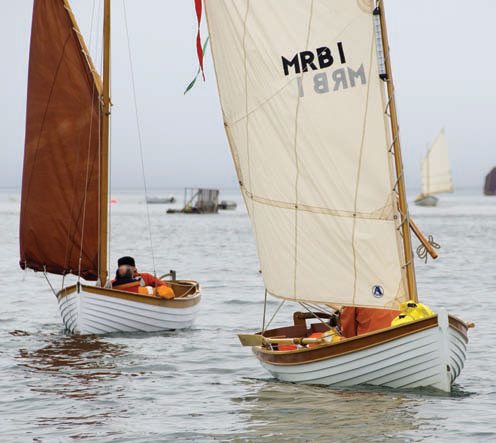 Benjamin Mendlowitz
Benjamin MendlowitzThe Atkin Little Scout (left) keeps up with the Moosabec Reach Boat.
There’s nothing like lapstrake planking to accentuate the lines of a hull. Each plank overlap (hence the name) forms its own lovely line, and when the planking job is done well, the lines all complement one another, like a topographic map of a hull. A nicely contrasting sheerstrake—left natural in the case of the Atkin Little Scout and the Moosabec Reach Boat —also helps to define the hull shape and show it to best advantage.
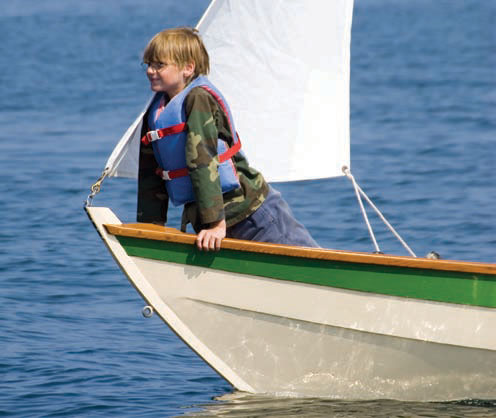 Benjamin Mendlowitz
Benjamin MendlowitzSean Irwin enjoys the day aboard SEA BISCUIT, an 18′ Swampscott dory.
Young Sean Irwin found his favorite place on his family’s 18′ sliding gunter-rigged Swampscott dory SEA BISCUIT, which had been constructed at WoodenBoat School. This day, he sailed with his father, Fred Irwin, and his grandfather, James Irwin, and by taking turns the family saw to it that everyone got a chance to sail. The Irwin family took volunteerism to a higher level, pitching in to take care of the campground, as they have been used to doing at Scouting events.
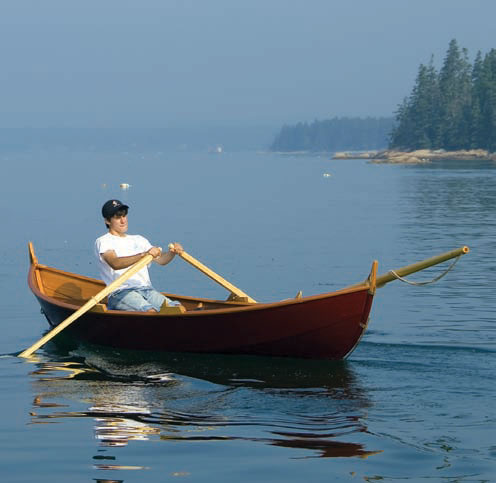 Benjamin Mendlowitz
Benjamin MendlowitzGavin Bauer rows an Oughtred-designed 15′ Elf faering.
Steven Bauer of Portland, Maine, finished building his Iain Oughtred-designed 15′ Elf faering just in time—in fact, he launched it for the first time on the first day of the event. She is a glued-lapstrake plywood construction, modified by the addition of built-in flotation tanks. Here, Steven’s son, Gavin, takes the boat through her rowing paces on a calm morning. Several participants had boats under construction, hoping to finish in time. Some did, but other boats had to wait for next year, and they’re unlikely to miss a second chance.
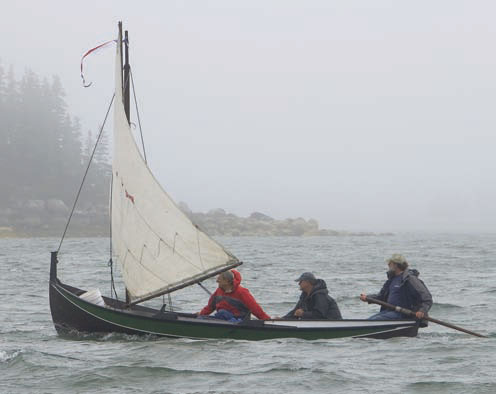 Benjamin Mendlowitz
Benjamin MendlowitzÅfjordsfaering LITEN KULING: a Norwegian-style double-ender.
Necessity is the mother of invention, they say, and steering with an oar over the stern became a necessity when the double-ended Åfjordsfaering LITEN KULING’s rudder popped off its gudgeons during a strong breeze. Once the boat gained the lee of an island, it was calm enough to get the rudder back in service. The fully traditional Norwegian-style double-ender, 19′ 6″ x 4′ 7″ and drawing 18″, was built by Jon Etheredge in 1988 while he was attending a Norwegian folk school before assisting in building a larger boat at The Apprenticeshop in Rockport, Maine, in 1989. She is one of the boats Ben Fuller made available—this one to WoodenBoat Senior Editor Tom Jackson, who didn’t finish building his new No Man’s Land boat in time for the 2007 Small Reach Regatta.
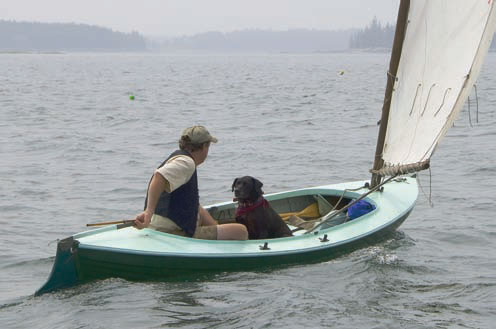 Benjamin Mendlowitz
Benjamin MendlowitzJohn Eastman and Jasmine enjoy a ride aboard JOSEF W.
Somehow it seems perfectly appropriate for a Delaware ducker to have a Black Labrador as crew, since the type was much admired on the Delaware River and the Jersey shore for fowl hunting and also for pleasure sailing. JOSEF W is a copy of GREENBRIAR, which was built by Josef W. Liener in the late 1940s and was itself a copy of a turn-of-the-last-century boat. JOSEF W was built by Mike Geer and Kevin Carney in 1978. One of Ben Fuller’s collection of small boats, she was on loan to Ben’s friend John Eastman (and his dog, Jasmine) one afternoon. The boat is only 15′ LOA, with a beam of 4′, and draws only 4″ with the centerboard up.
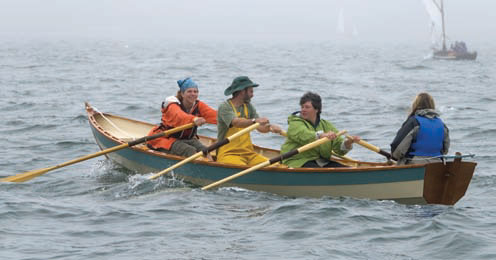 Benjamin Mendlowitz
Benjamin MendlowitzThe Head family rows SMALL REACH 20 along the water.
Late August on the coast of Maine can be breezy, foggy, hot, calm, or all of the above. September is cooler and breezier, and the risk of fog and calms greatly diminishes—but the risk of rain or too much wind is greater. In the end, we chose late August so families would be more apt to participate.
The success of the strategy was proven several times, and one good example came from Allen Head of Concord, New Hampshire, who designed a boat specifically for his family to use. He’s calling it the Small Reach 20, and it’s large enough for Allen and his wife, Lynn, and their son Seth, 17, and daughter Casey, 15 (who had her own boat when she was but 6 years old), to get out on the water together. The six-oared boat is 20′ LOA with a 5′ beam. She is modeled after a Swampscott dory, and because she is built in glued-lap plywood construction, she weighs only 250 lbs.
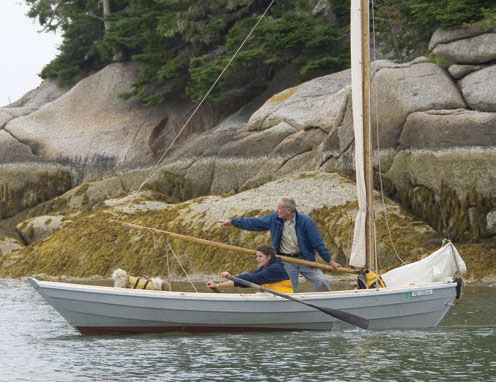 Benjamin Mendlowitz
Benjamin MendlowitzWillits Ansel aboard a Swampscott dory he completed in 2007.
Willits Ansel, long of the Mystic Seaport duPont Preservation Shipyard (see WoodenBoat No. 171) but now retired, builds boats to his own designs, starting always with a half-hull model. His new boat, completed in the spring of 2007, is a Swampscott dory, for which he borrowed sails from one of his earlier sharpies. His finishes are workboat-style: understated, simple, uncomplicated, allowing the boat to rely purely on shape for its considerable appeal. The traditional cedar-over-oak hull looks perfectly at home on the granite-bound coast of Maine.
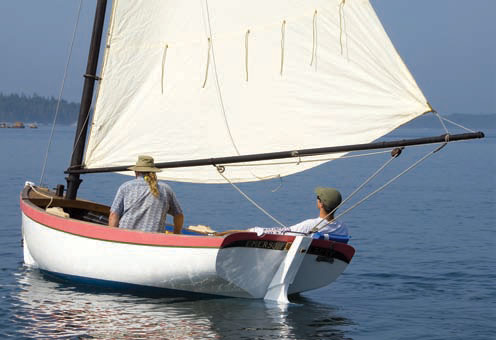 Benjamin Mendlowitz
Benjamin MendlowitzEMERSON ALBURY, an Abaco dinghy built on Man-o-War Cay in the Bahamas.
Great variety is one of the hallmarks of a great small-boat fleet. EMERSON ALBURY literally brought some color to the waterfront, painted as she is in Caribbean colors of red, yellow, pink, blue, and green—combinations not often chosen by New England Yankees. She’s an Abaco dinghy, built on Man-o-War Cay in the Bahamas. She is a burdensome boat for her 16′ 6″ length, but even with her 2′ draft with lots of drag to the keel, she proved able in beaching and surprisingly easy to get on and off her trailer. Wade Smith, her owner, is the director of the John Gardner Boat Shop at Mystic Seaport and organizes the John Gardner Small Craft Workshop, held at the Seaport each June.
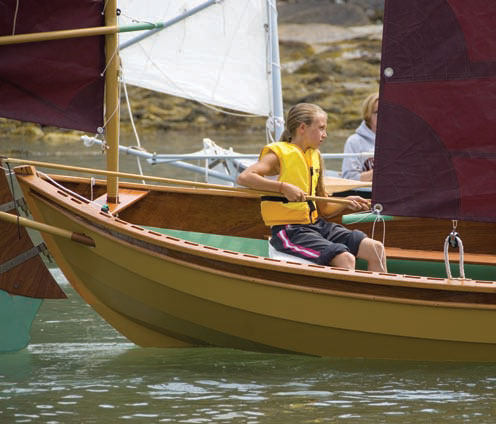 Benjamin Mendlowitz
Benjamin MendlowitzJasmine Drouin, 12, pilots an Iain Oughtred-designed Caledonia yawl.
Jasmine Drouin, 12, was right at home at the helm of the 19′ 6″, Iain Oughtred–designed Caledonia yawl only recently launched by her father, Christopher, of Auburn, New Hampshire. She was already accustomed to the yoke tiller—a “push-pull” device that takes a bit of getting used to—from four years of sailing a Skerry, a 15′ double-ender designed by Chesapeake Light Craft, which Christopher had built earlier.
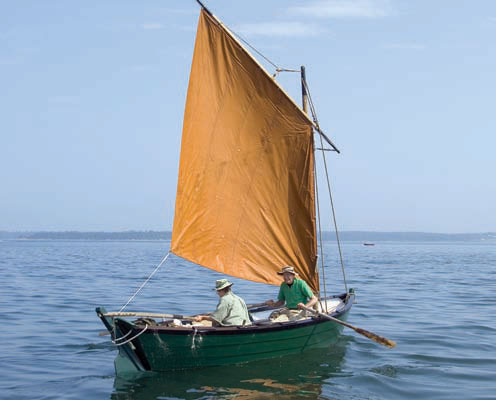 Benjamin Mendlowitz
Benjamin MendlowitzSam and Susan Manning sail the 19’6″ HOPEFUL OUTLOOK.
Some of the boats in the fleet were like old friends. For several decades now, Sam Manning has been a boatbuilding illustrator for WoodenBoat magazine and more books than we can count by more publishers than we can remember. He and Susan sail and row their Banks dory HOPEFUL OUTLOOK year-round out of Camden, Maine, often breaking through ice to get clear of the harbor in the winter. The dory is a large one, at 19’6″ overall, but she sails well and rows well.
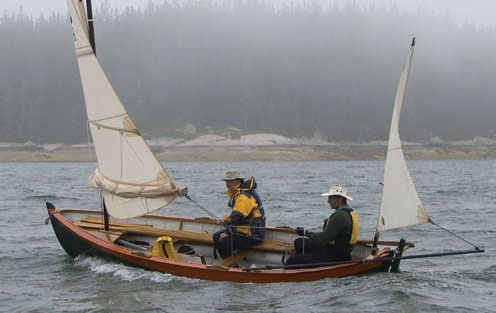 Benjamin Mendlowitz
Benjamin MendlowitzTwo sailors pilot the 17’6″ RAN TAN.
Traditional appearances can be deceptive: RAN TAN, built to Tony Dias’s Harrier design, is a lightly built glued-plywood lapstrake hull built for performance but also for convenient camp-cruising. Her masts are of carbon fiber, and her sails are full-battened. She is 17′ 6″ LOA, 5′ beam. She draws only 6″ of water with the centerboard up, making her easy to maneuver on and off a beach, and with her narrow, flat bottom she can stand upright when she gets there.
RAN TAN was designed with input from her owner, Ben Fuller of Cushing, Maine, with coastal cruising specifically in mind. She is one of Fuller’s gaggle of small craft of a range of descriptions, many of them—including this one—on loan to friends for the 2007 Small Reach Regatta.
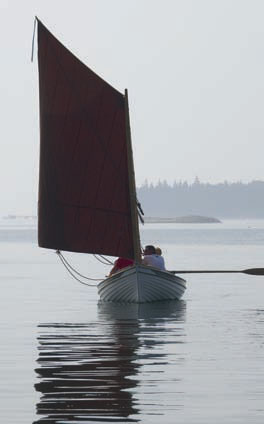 Benjamin Mendlowitz
Benjamin MendlowitzBELLA BARCA sails into the fog.
Like the “Raids” that started in Europe, the core concept of the 2007 Small Reach Regatta is that boats and crews need to be capable of independent navigation in all conditions without assistance, unless safety demands help from one of several chase boats. High wind and dense fog are among the conditions—but another is light air or dead calm, in which case miles can be covered under oars, or “motorsailing” with oars augmenting the sail’s scant power. The Pete Culler Kingston lobsterboat BELLA BARCA’s tanbark-colored sails diminish the glare of the bright sun for those on board but also reflect playfully on the surface.
This article was originally published in the Small Boats Annual 2008 special edition. For a recap on the history of the event, read “Fifteen Years of the Small Reach Regatta” by Tom Jackson.
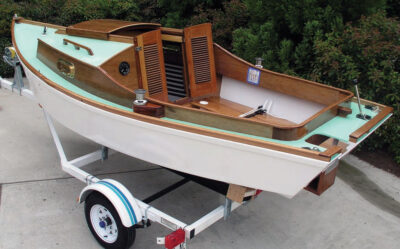
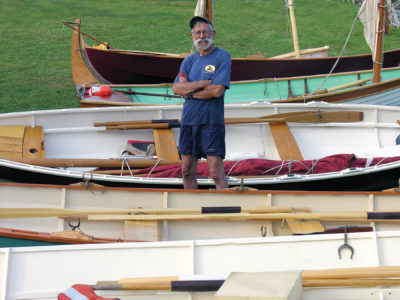
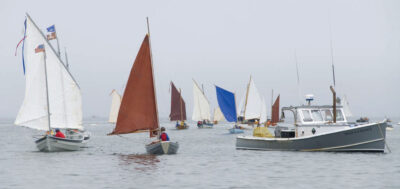
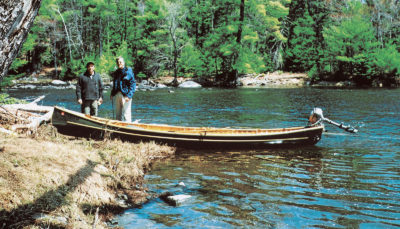
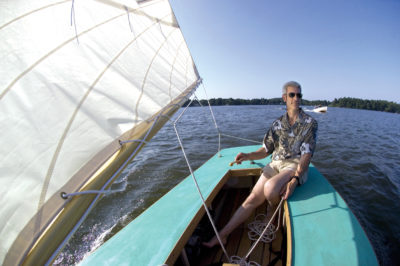
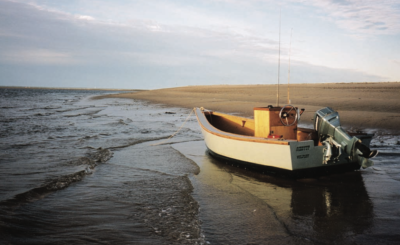
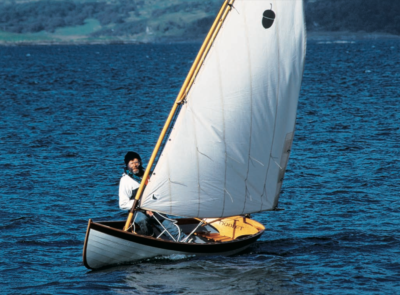
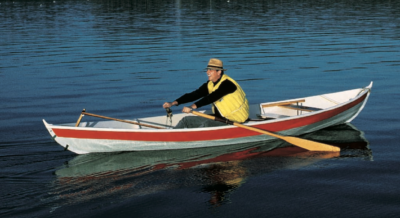
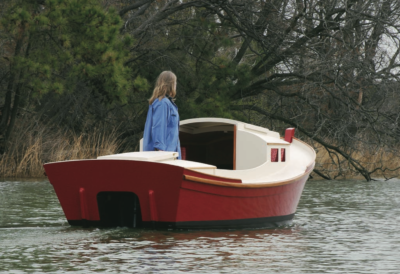
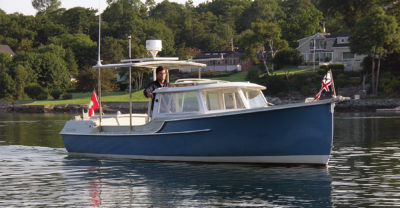
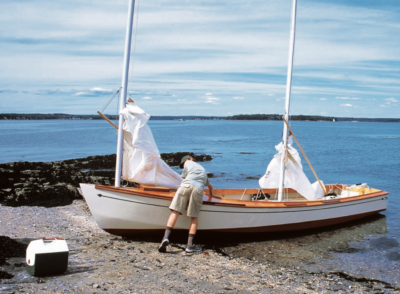
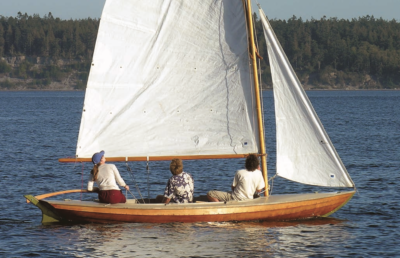
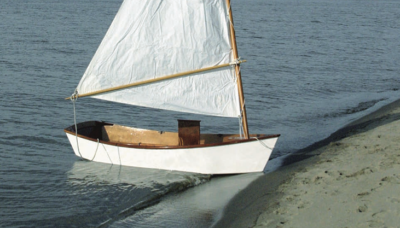
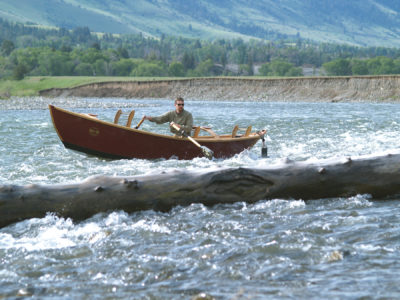
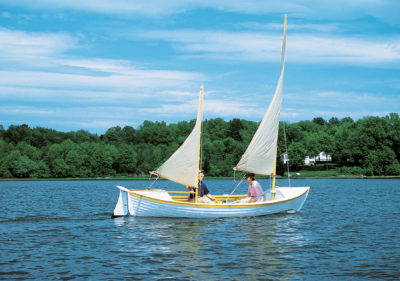
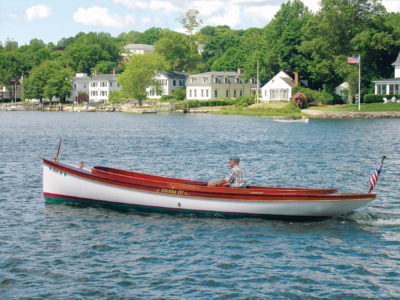
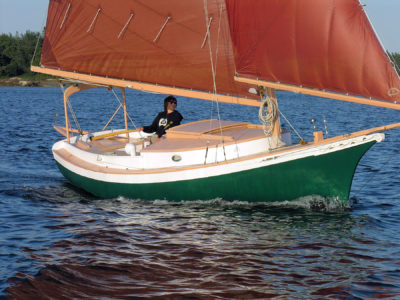
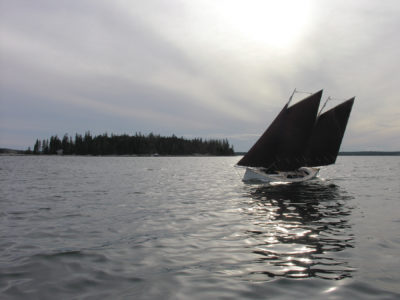
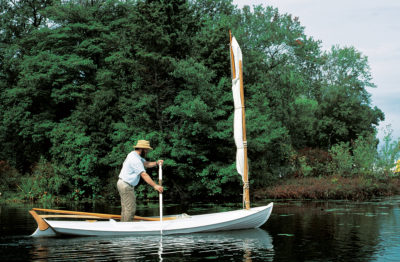
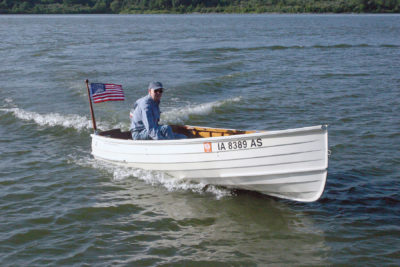
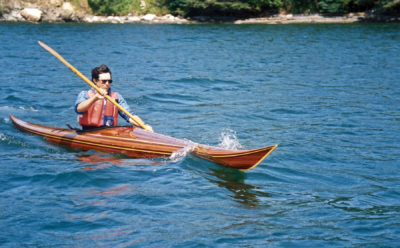
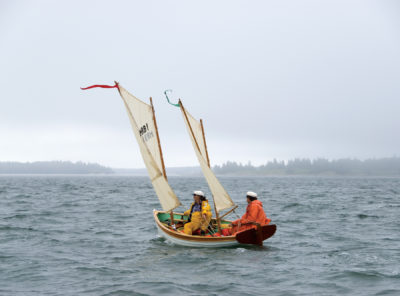
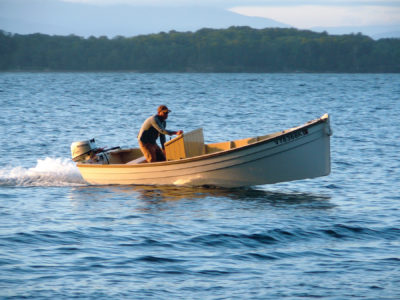
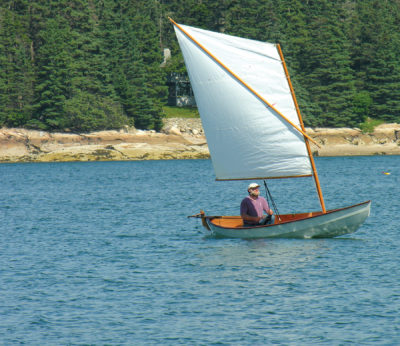
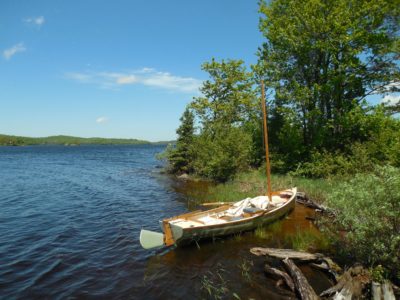
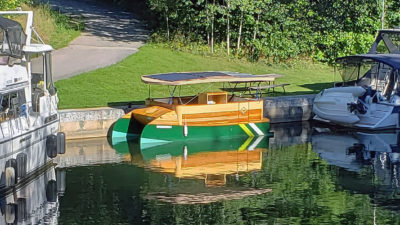
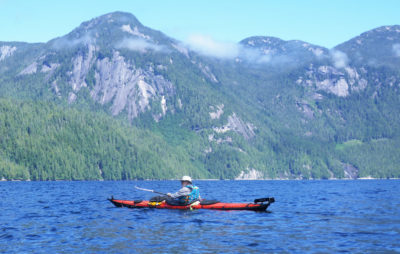
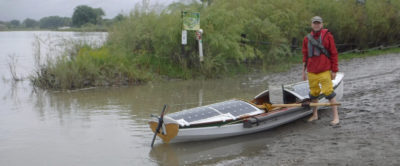
Join The Conversation
We welcome your comments about this article. To include a photo with your remarks, click Choose File below the Comment box.